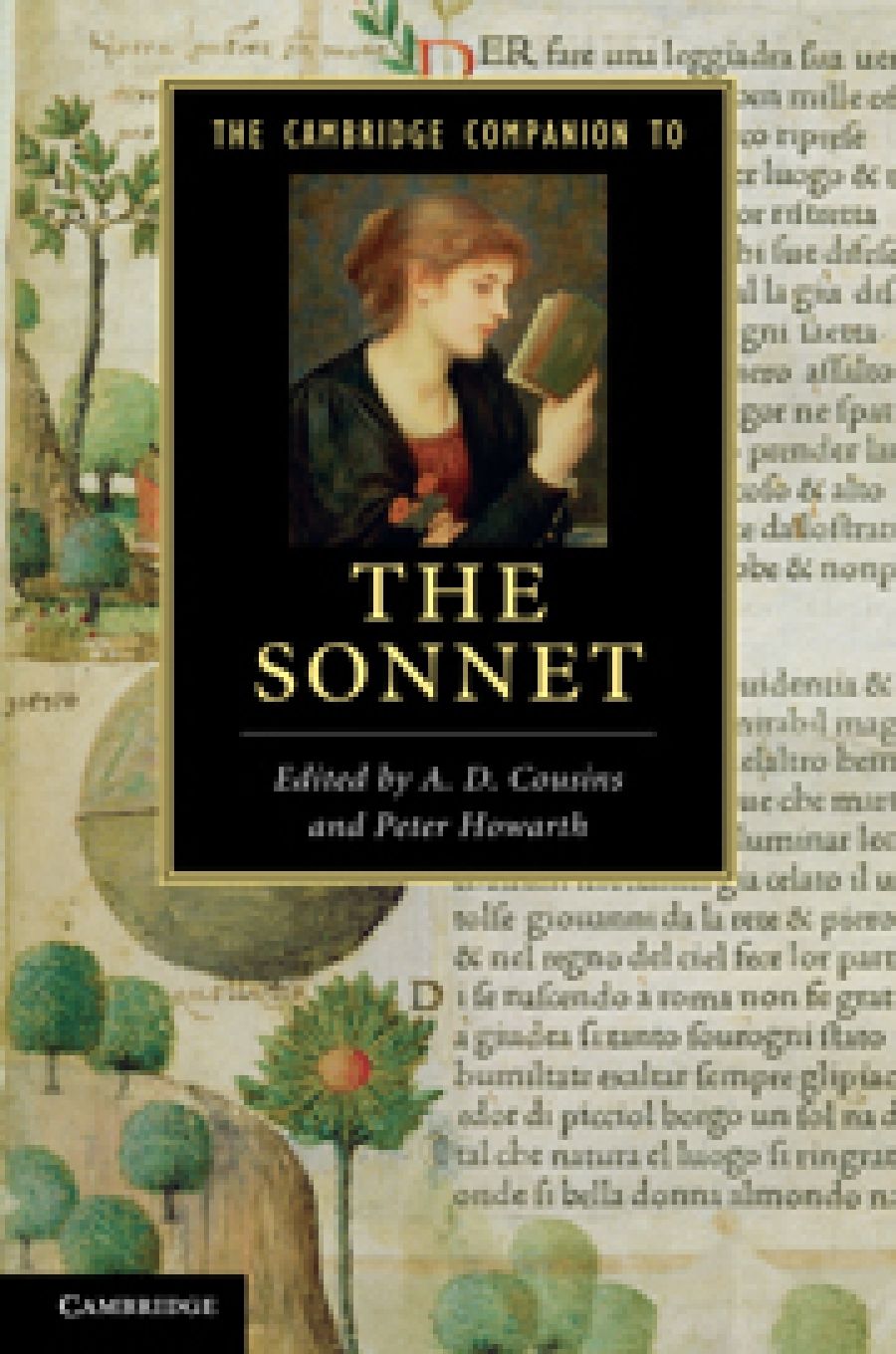
- Free Article: No
- Contents Category: Literary Studies
- Custom Article Title: William Christie reviews 'The Cambridge Companion to the Sonnet' edited by A.D. Cousins and Peter Howarth
- Review Article: Yes
- Online Only: No
- Custom Highlight Text:
It is a measure of the stature of William Wordsworth among his younger contemporaries that he would find himself subject to innumerable challenges over the early years of the nineteenth century. What upset the second generation of Romantic poets – Percy Bysshe Shelley, Lord Byron, and, to some extent ...
- Book 1 Title: The Cambridge Companion to the Sonnet
- Book 1 Biblio: Cambridge University Press, $34.95 pb, 290 pp
To express the paradox of liberty sought within inevitable constraints, Shelley chose the sonnet form, which by the end of the eighteenth century ‘was once again truly alive’, as R.S. White remarks at the close of the ninth chapter of this comprehensive companion to the sonnet in English from A.D. Cousins and Peter Howarth. At every point, Shelley uses Wordsworth’s own poetry both for and against Wordsworth himself; before anything else, ‘To Wordsworth’ is a serious parody of the ‘embattled’ dignity of the best of Wordsworth’s (and Milton’s) public sonnets. Indeed, addressing Milton in a sonnet entitled simply ‘London, 1802’, Wordsworth had used the same image:
Thy soul was like a Star, and dwelt apart;
Thou hadst a voice whose sound was like the sea:
Pure as the naked heavens, majestic, free
If a single source were required for ‘To Wordsworth’, this would be it, and Shelley’s sonnet seen as a tendentious rewriting designed to hoist Wordsworth on his own petard.
‘To Wordsworth’, however, also alludes to Coleridge (whose Sonnets on Eminent Characters [1795], as Michael O’Neill reminds us, revived the vogue for the public, political sonnet after its lull in the eighteenth century), to Milton, to Shakespeare – indeed, to the whole tradition of the sonnet, invoked by Shelley’s images of the ‘lone star’ and ‘frail bark’, which echo the ‘star’ and ‘bark’ of Shakespeare’s sonnet 116, a poem about love and constancy to an ideal – as the tradition of the amatory sonnet from its beginnings in the Sicilian court of the thirteenth century had been about love and constancy to an ideal. And, like Shelley’s ‘To Wordsworth’, Shakespeare’s is a homoerotic protest addressed by one male to another – his superior, his beloved, and, as the sequence itself suggests, his betrayer:
... love is not love
Which alters where it alteration finds,
Or bends with the remover to remove.
Oh no! it is an ever-fixèd mark,
That looks on tempests and is never shaken;
It is the star to every wandering bark
Whose worth’s unknown although his height be taken.
It doesn’t end here. The sonnet tradition is nothing if not repetitive, and Shelley’s and Shakespeare’s frail and wandering ‘bark’ can be found bobbing up all over the place in the work of perhaps the greatest – certainly the most renowned – of the sonneteers, Francesco Petrarca, or Petrarch as we know him in English (featured in William E. Kennedy’s chapter in this volume).
Wordsworth himself, then Coleridge, back to Milton, thence to Shakespeare, Petrarch, Dante: here were the stars of the constellation as Shelley and other poets of the period conceived or were in the process of conceiving it, the ever-fixèd marks that could look on the tempests of the time being and never be shaken. This is the promise being held out to Wordsworth – along with the threat that, in renouncing the politics of his youth, Wordsworth may have sacrificed his canonical ascendency along with his independence.
‘Be it Milton lauding Shakespeare, Wordsworth invoking Milton or John Berryman recalling Sidney,’ writes Diana E. Henderson in a chapter on ‘The Sonnet, Subjectivity and Gender’, ‘the conversation across generations now allows what began as a radically internalized form to create communities of sense and sensibility, to be both individualized and in dialogue, to tear down and reconstruct identities. From fourteen lines to infinity: the sonnet carries on.’ The truth is, the sonnet and its sequences, born as courtly exercises, were always communal, quizzing the notion of the personal by their very conventionality. And yet their very conventionality holds out a challenge to individualise, making the sonnet (as it is often seen) a representative poetic form. (This is the thrust of A.D. Cousins’s characterisation in chapter 7 of Shakespeare’s sonnets, which become more conventional the more intensely idiosyncratic they appear.) Since the claims that in its occult division into octet and sestet the early sonnet ‘evinces mystical proportions of Pythagorean or Platonic musical number theory’, no one has tried to suggest that the number of lines in a sonnet was divinely or genetically programmed, durable though it has proved. The sonnet’s arbitrary length and identifiable characteristics – fourteen lines of decasyllabic and/or pentameter verse; an octave divided from a sestet; a clear argumentative line with an intellectual or emotional turn (volta); intricate internal rhymes and rhetorical virtuosity; and so on – make it a test case for the expressive and repressive potential in all poetic convention (liberty and constraint). This conventionality has also proved an interesting test for the modern writer (such as Paul Muldoon, Meg Tyler, and Jeff Hilson, in trialogue in the first chapter), determined to be free but aware that, in working with language itself, they remain in the grip of the most expressive and repressive of all conventions.


Comments powered by CComment